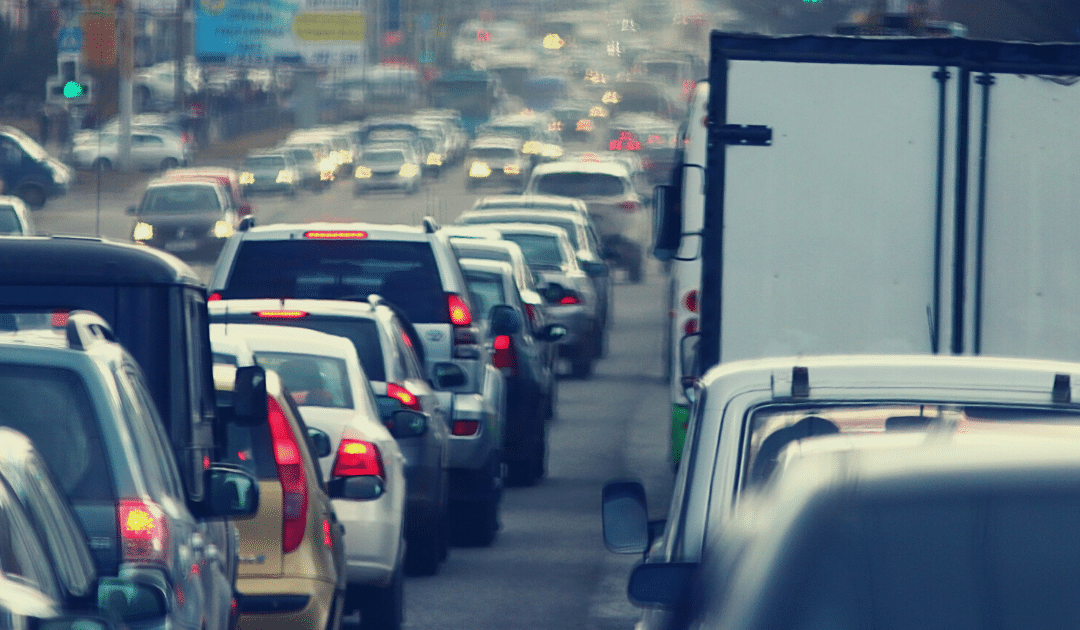
by California Casualty | Auto Insurance Info, Safety, Travel |
The holidays are HERE, and unfortunately so is the holiday traffic. As millions hit the road to travel near and far this holiday season roadways will quickly become overly congested, traffic delays more frequent, and holiday road rage will start to set in for many drivers.
If you are like the thousands of Americans hitting the road this season, follow our holiday traffic safety tips below.
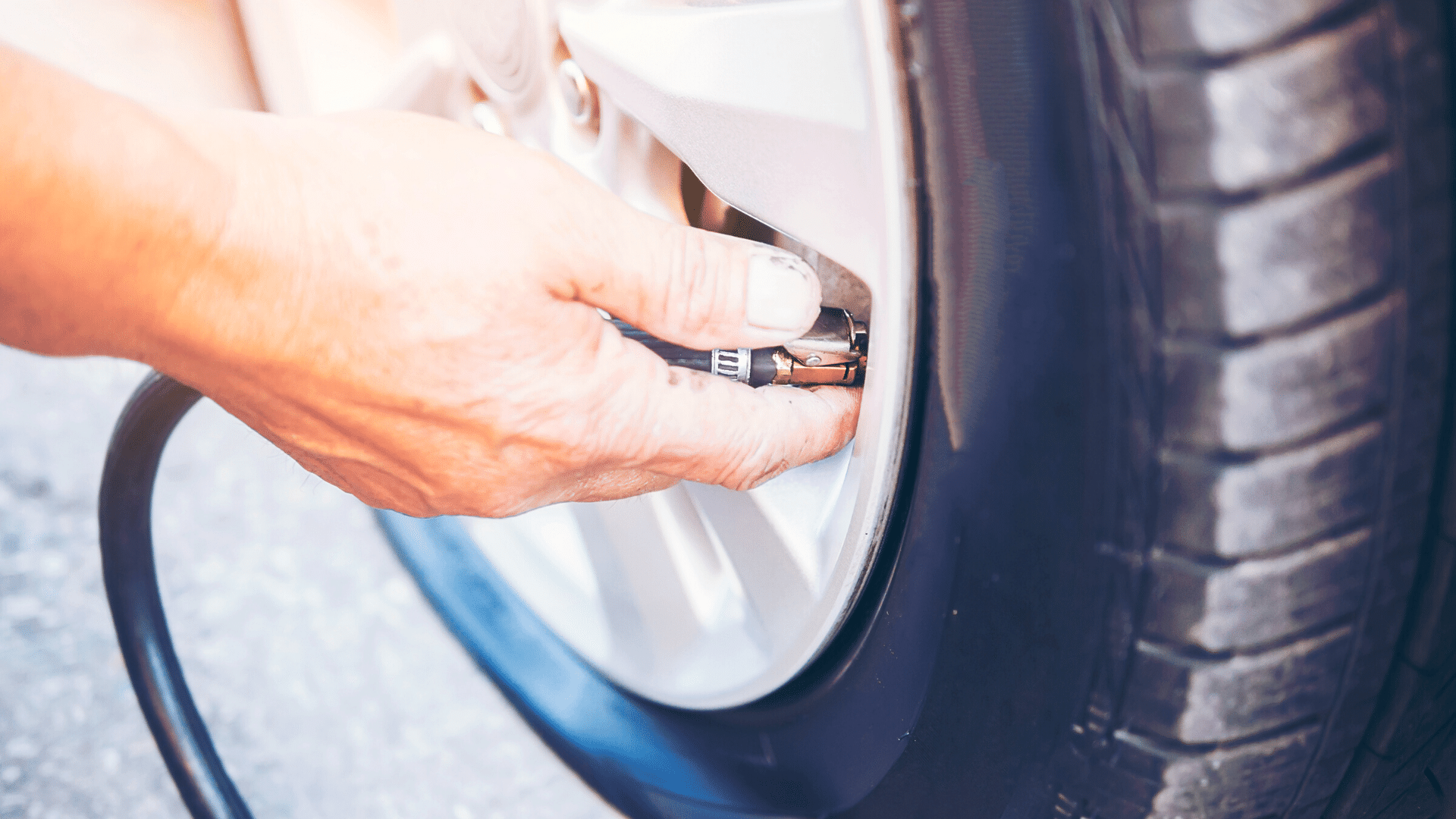
1.Plan Head
Before you hit the road make sure your vehicle is properly maintained and ready for the trip. Plan out your route ahead of time, and if it’s possible, avoid driving through areas you know will be jammed with holiday traffic. Before you head out it’s also a good idea to check the forecast and plan ahead for inclement weather. Don’t forget to pack your emergency car kit!
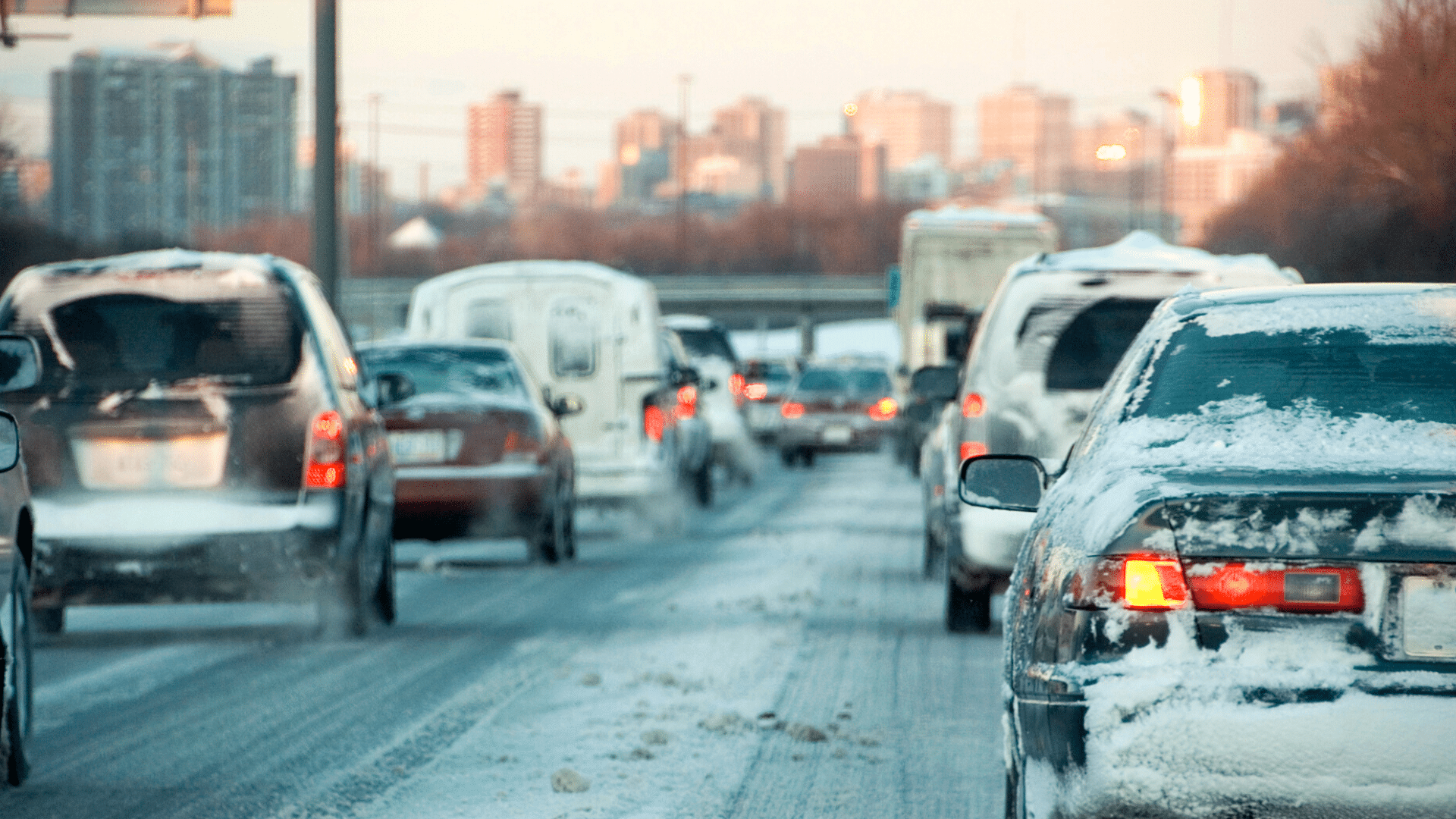
The more traffic, the higher the chance for an accident. It’s important not only to drive safely, but also to keep an eye on other drivers. In holiday traffic jams always expect the unexpected, watch for drivers cutting you off, slamming on their breaks, speeding up and slowing down, etc. Be prepared for anything, and always stay attentive behind the wheel.
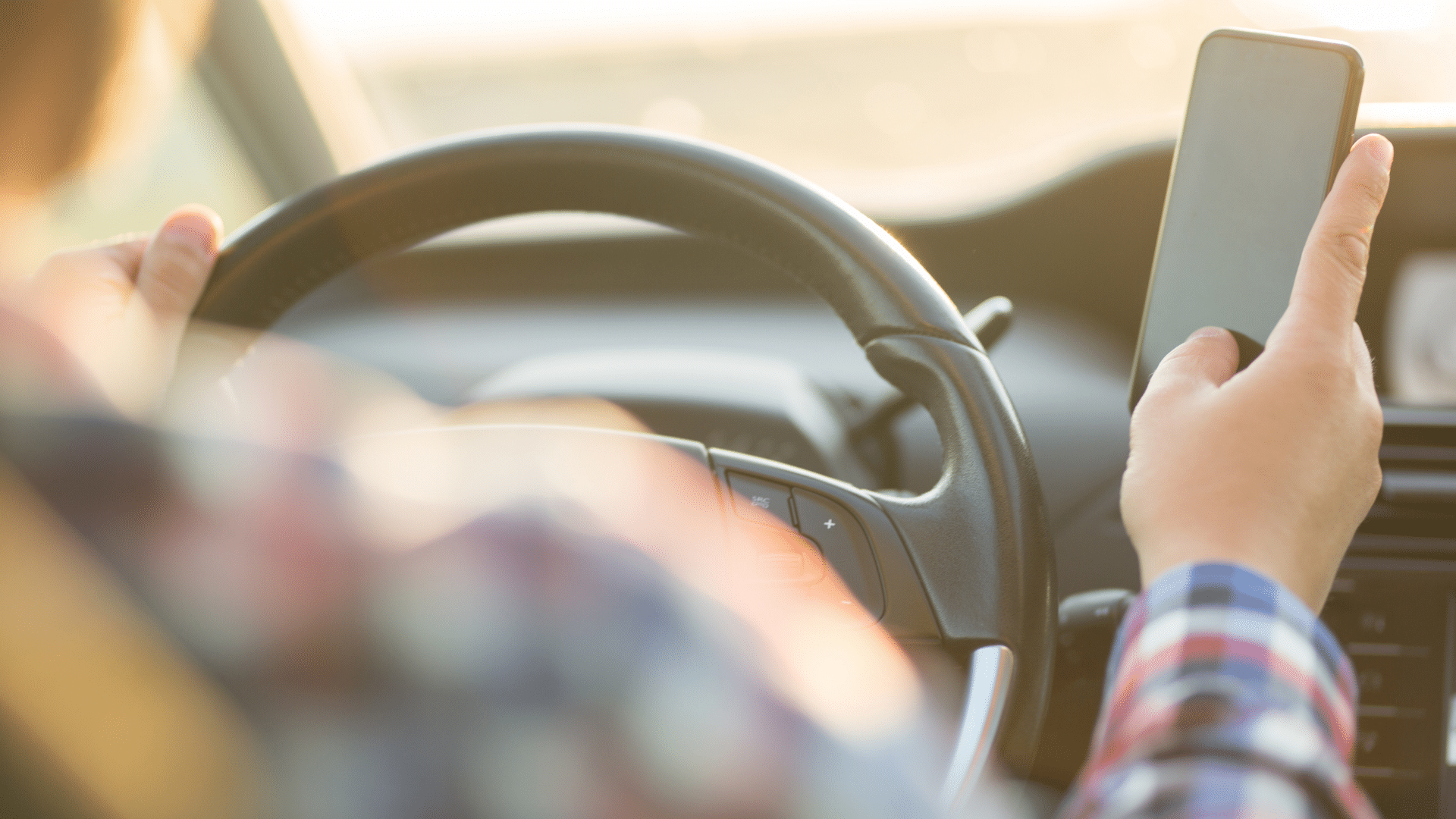
3. Avoid Distractions
Distracted driving causes thousands of fatal traffic accidents every single year. Add in holiday traffic and distracted driving becomes even more dangerous and deadly. We know it can be hard to avoid common distractions like your phone, especially when you are driving long distances by yourself, but it’s important for your safety that you keep your eyes on the road and your hands on the wheel at all times.

4. Keep Your Cool
If someone makes a decision that makes you angry when you are driving, try not to let it affect you. This may be hard, but getting angry doesn’t solve anything. Road rage is a form of distracted driving because you cannot think clearly. If you start to feel yourself becoming angry or anxious try listening to music, taking deep breaths, and remember there is nothing you can do about other driver’s decisions or to make traffic move quicker- so stay calm.
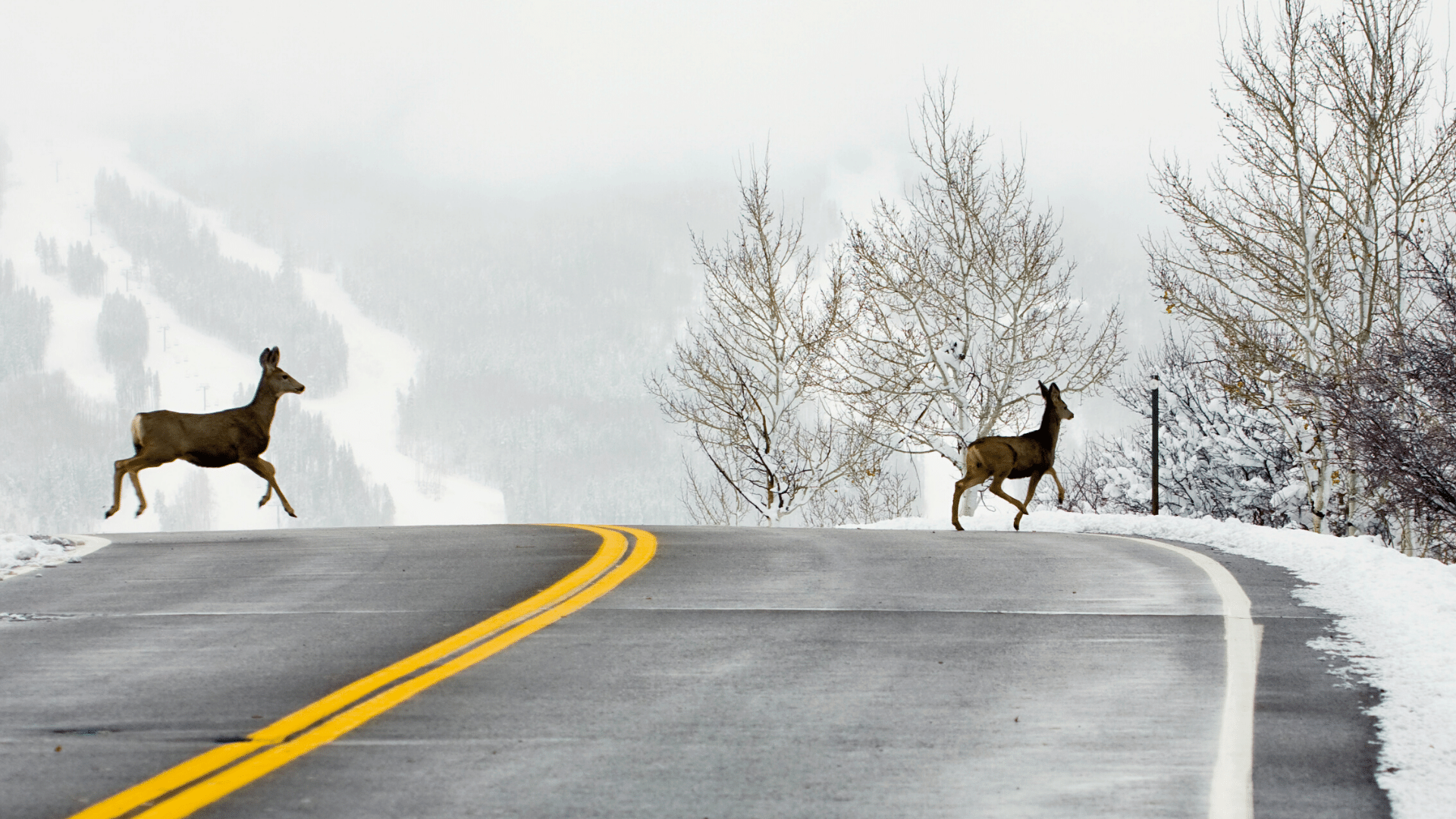
5. Watch for Animals
Deer move with cold fronts. This means as the temperature continues to drop and as we get closer to the end of the year, the likelihood of seeing or hitting a deer increases. Hitting a deer, or any other animal, can total your vehicle, hinder your plans, and even cause serious injury (or death). Stay alert and watch for animals, especially if you choose to travel in rural areas at night.
If you plan on making multiple stops or staying at any hotels during your trip, be sure to follow our Traveling Safely During the Pandemic guide.
Safe travels and Happy Holidays! 🙂
This article is furnished by California Casualty. We specialize in providing auto and home insurance to educators, law enforcement officers, firefighters, and nurses. Get a quote at 1.866.704.8614 or www.calcas.com.
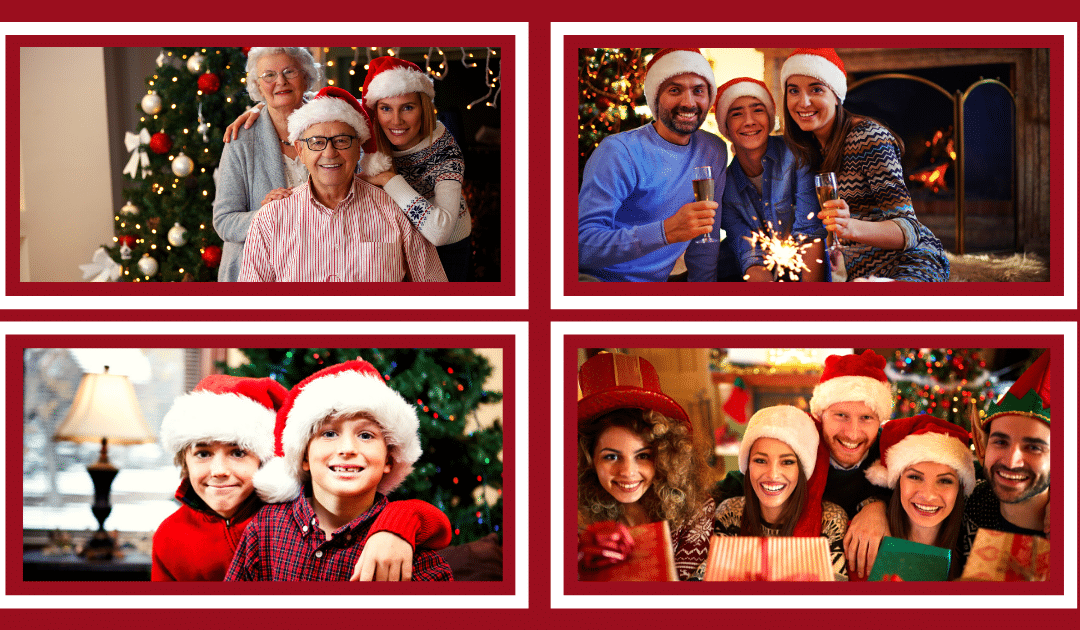
by California Casualty | Educators, Safety |
Much like all else in 2020, this holiday season is sure to look a little different this year. And unfortunately, many of us will not be together, like we had planned; but that doesn’t mean we have to miss out on all of the fun with our friends and families!
Whether you are a teacher hosting a party for your remote learning class or a family staying socially distant at your holiday gathering, we’ve got an array of ideas to help you have fun at your virtual holiday party.
Check out our list of Zoom holiday party ideas below.

1.Virtual Ugly Sweater Contest
No holiday party is complete without everyone going completely all out in their festive gear! Invite each person on your Zoom call or in your virtual classroom to show off their ugly sweaters and have everyone vote on their favorites.
Don’t want anyone to have to buy an ugly sweater? Try dressing up with Santa hats, elf ears, or reindeer antlers; or hold a contest for the best holiday decor or funniest holiday Zoom background! The possibilities are endless. For prizes print off certificates or send e-gift cards.

2. Play a Game
There are tons of games that you can play together with your class or friends and family that can be taken virtual like: Trivia, Simone Says, Scattergories, Heads Up, 20 Questions, Zoom In, etc. Here are a few funs ones that you can try with your crew:
-
- Carol Pictionary
- Use the Zoom whiteboard feature, split into teams and take turns guessing the carol that is being drawn, you must SING the carol to win.
- Charades
- Come up with a fun list of Holiday sayings or movie titles, have everyone split into teams, and let the fun begin
- Festive Bingo
- Make or buy virtual bingo cards and email them out prior to your event
- Name That! – Holiday Edition
- Have someone volunteer to DJ (if you are a teacher that means you) and challenge your guests to name that Holiday Tune! You could even play using short youtube clips of your favorite festive movies.
- Guess the Gift
- Have each player wrap something up as a “gift” and everyone else try and guess what it is by asking only questions!
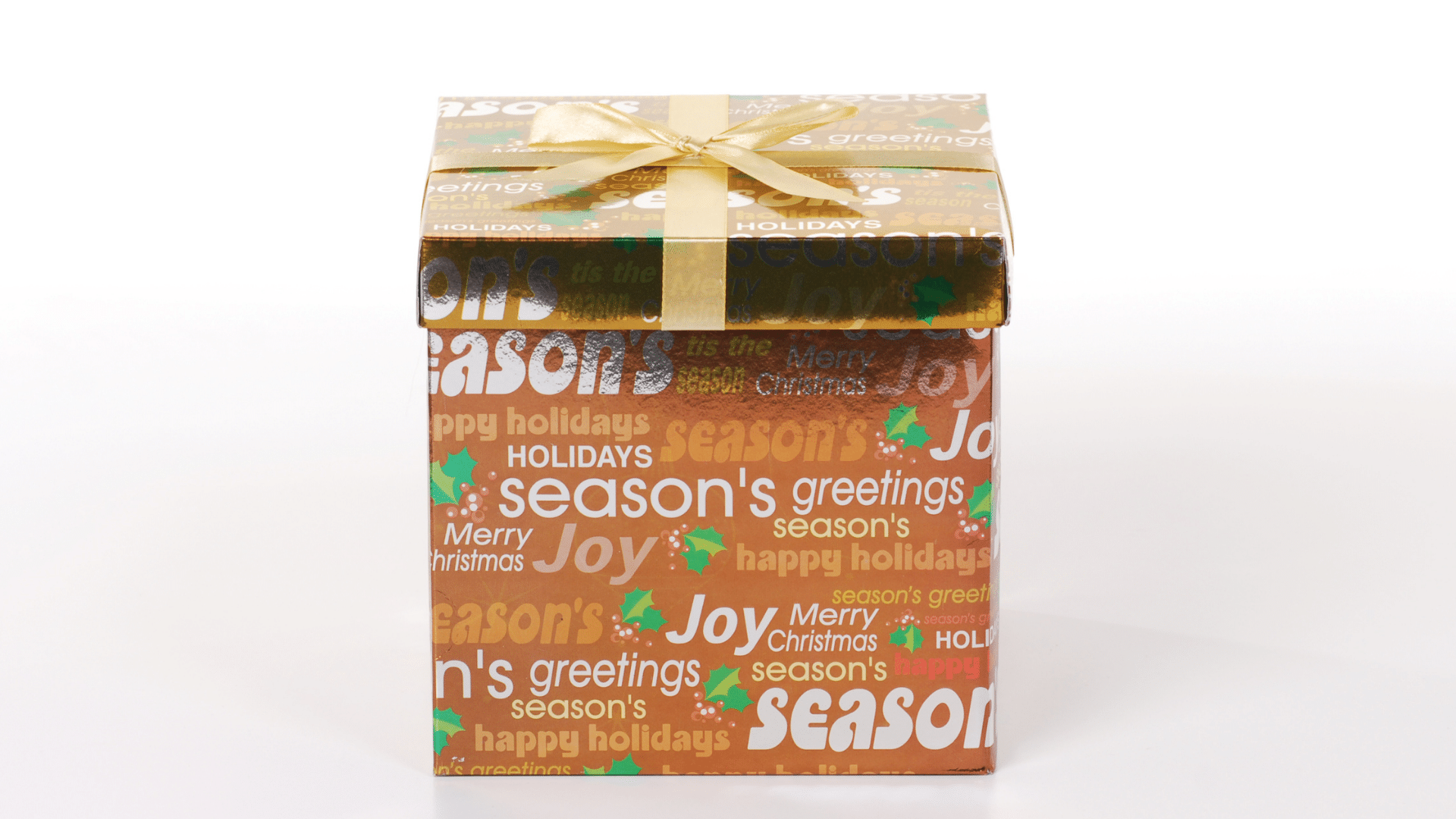
3. Send Holiday Gift Boxes & Open Them
Wish everything going on in the world today, it can be hard to get into the holiday spirit. Sending a holiday gift package can be an easy way to spread cheer and a physical reminder that even though you are apart, you can still celebrate together. You can even have everyone wait to open them until you are on your virtual call together. Here are some ideas of what you can include in your packages:
For Students: Holiday bingo card, hot chocolate, holiday-themed or cozy socks, a handwritten note, holiday-themed pens, pencils, or note pads, candy
For Friends and Family Members: Holiday games to play, homemade treats, holiday drinking favorites, gift cards, holiday-themed clothing items: ugly sweaters, hats, socks, etc., blankets, holiday movies, photo booth prompts

4. Do Holiday Crafts
What’s not to love about holiday crafting? It’s cheap and something that you can do with people of all ages. You can even keep your creations and use them as decorations next year! Here are some easy(ish) holiday crafting ideas to try:

5. Host a Virtual Holiday Scavenger Hunt
This past year we’ve all spent a lot of time sitting behind the screen. Scavenger hunts are easy ways to get everyone up and moving and they are so easy to do! To make an at-home holiday scavenger hunt, come up with a list of festive items or descriptions of items that can easily be found inside everyone’s home this time of year (or you could just find one on Pinterest).
If you plan on making your own scavenger hunt here are some easy ideas to put on your list:
-
- Something shiny
- Something makes noise
- Something the Grinch would love
- Something you could put in a stocking
- A prop that could have been used in “Home Alone”
- Something a reindeer would eat
- Something better than presents
- Something you could use as a Tree
- Something that resembles snow
- Something as tall as an elf
- Something you can tie into a bow
Have a good laugh when everyone comes together (virtually) to share their findings!
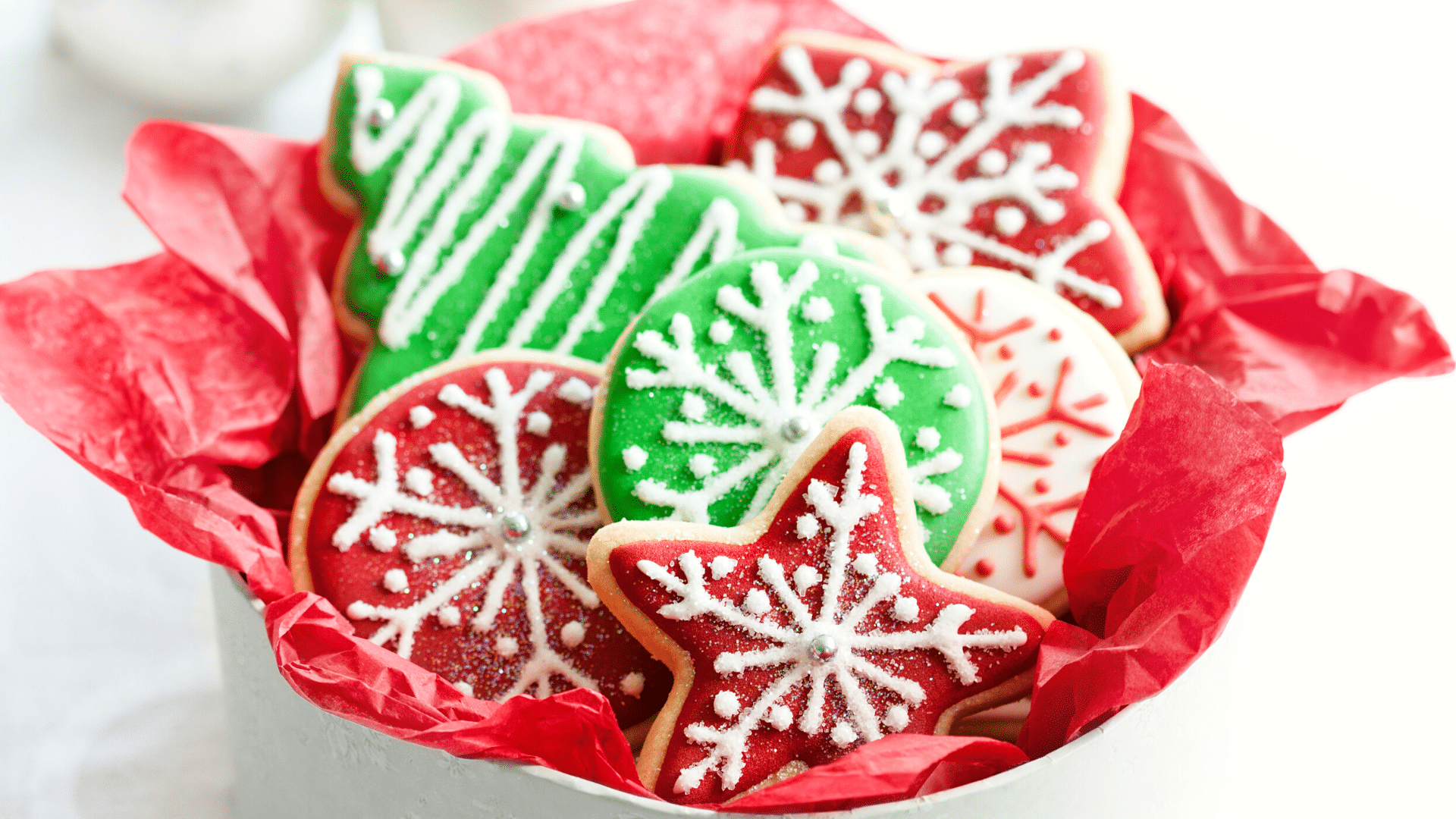
6. Enjoy a Holiday Treat Together
What brings people together more than food? Exactly. Have everyone bring one (or more than one) of their favorite treats to the party to enjoy while doing other activities!
For Teachers: You can send them holiday treats before your party, or have them bring a treat of their choice (doesn’t have to be holiday related) to eat with their peers while having fun!
For Friends and Family Members: Make your favorite holiday dishes or desserts to enjoy surrounded by your favorite people.
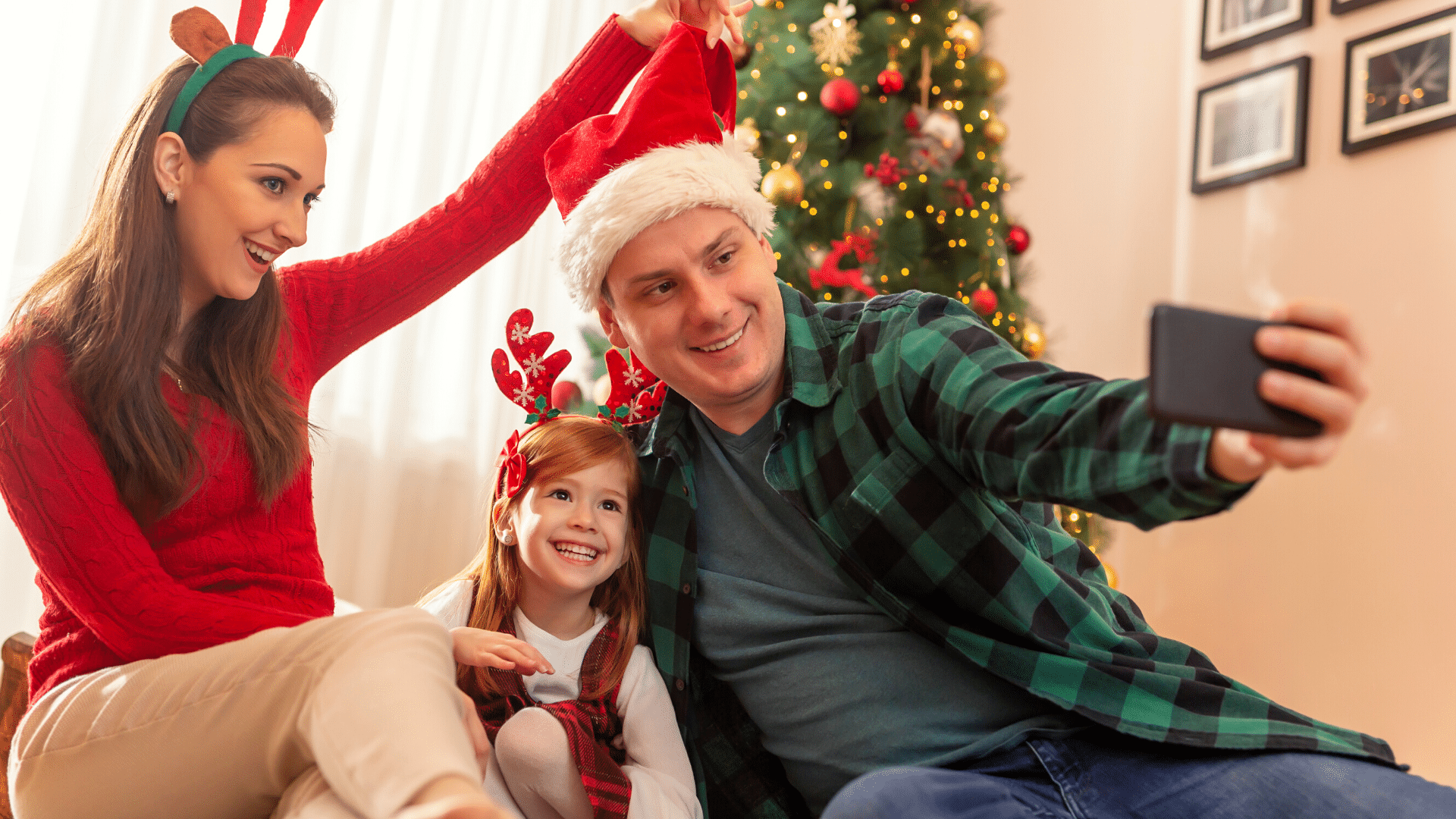
7. Host a Talent Show
Have each person come to the virtual party with a Holiday talent in mind to show off to their peers. This can be anything from acting out a Holiday movie, singing or playing an instrument to the tune of a Carol, showing off their design skills by dressing up as a well-known character, telling Holiday Jokes, decorating cookies, or gingerbread, etc.
The talent show is purely for entertainment purposes and should be voluntary so shyer party-goers can sit back and have fun watching the show, but don’t forget to send out a signup sheet at least a week before so everyone has time to prepare!
and last but not least, remember to…
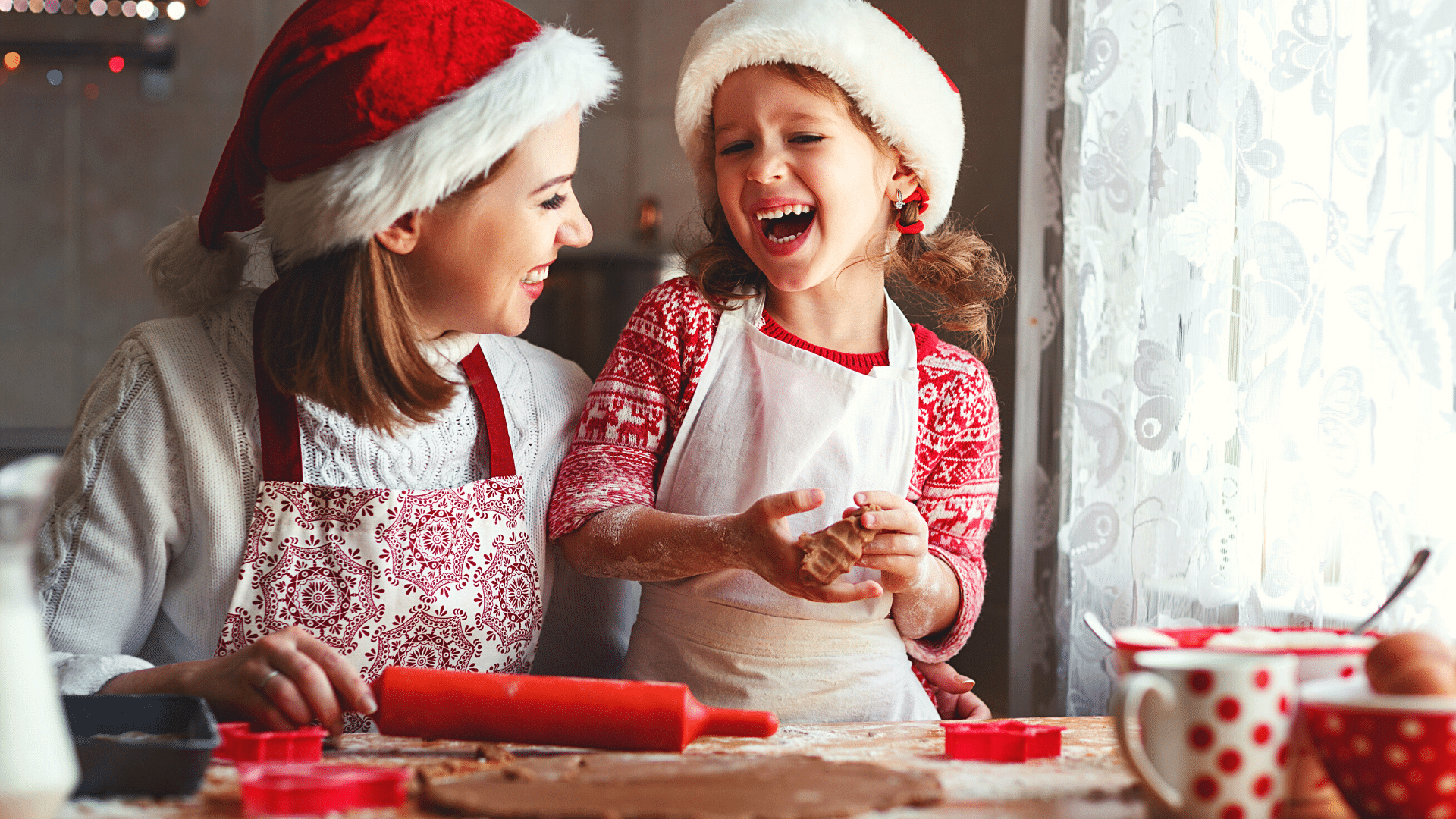
8. Keep Up With Any Traditions
We may not all be together right now, but that doesn’t mean we should stop partaking in our holiday traditions. It may take some adapting, but you’ve got this! It’s important (especially for our kids) that we can continue to make happy memories during the most wonderful time of the year.
For Teachers: If it’s traditional for your kids to create holiday cards for their parents- send your kids a holiday card template, let them decorate it, and give it to their parents. Or if you usually make ornaments, take time during your virtual party and work together online as a class to create them!
For Friends and Family Members: If your family has traditions like baking together, singing carols, putting on your new PJs, and watching movies- you can do all of these things virtually at your holiday party as well. Sure, it’s not the same as being together, but it’s the next best thing.
Don’t forget! – No party is complete without some festive tunes! Check out our kid-friendly Holly Jolly Holidays Playlist on Spotify to set the mood for your virtual holiday party this season. Click here to listen.
This article is furnished by California Casualty. We specialize in providing auto and home insurance to educators, law enforcement officers, firefighters, and nurses. Get a quote at 1.866.704.8614 or www.calcas.com.
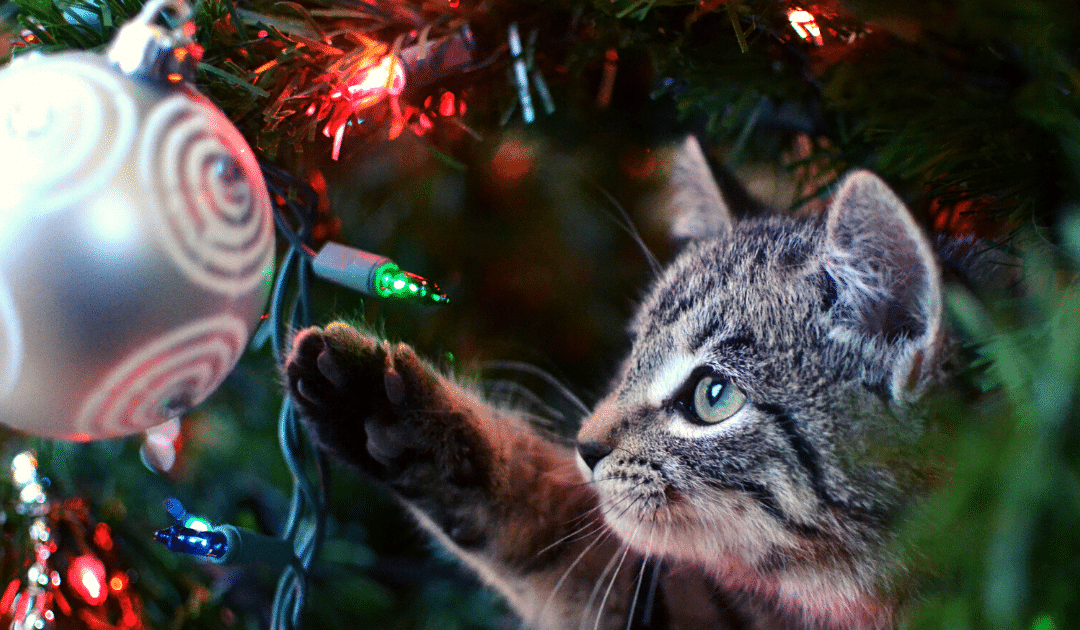
by California Casualty | Pets, Safety |
From Mr. Kitty’s stocking on the mantle to themed doggie sweaters and chew toys under the tree, no holiday is complete without our beloved pets. The more meows (and zoomies), the merrier!
As you start decking the halls and crafting your holiday cooking list, remember there are some foods, décor, and holiday novelty items that may put your pet at risk. Check out these tips to keep them safe, happy, and healthy during all your seasonal festivities.
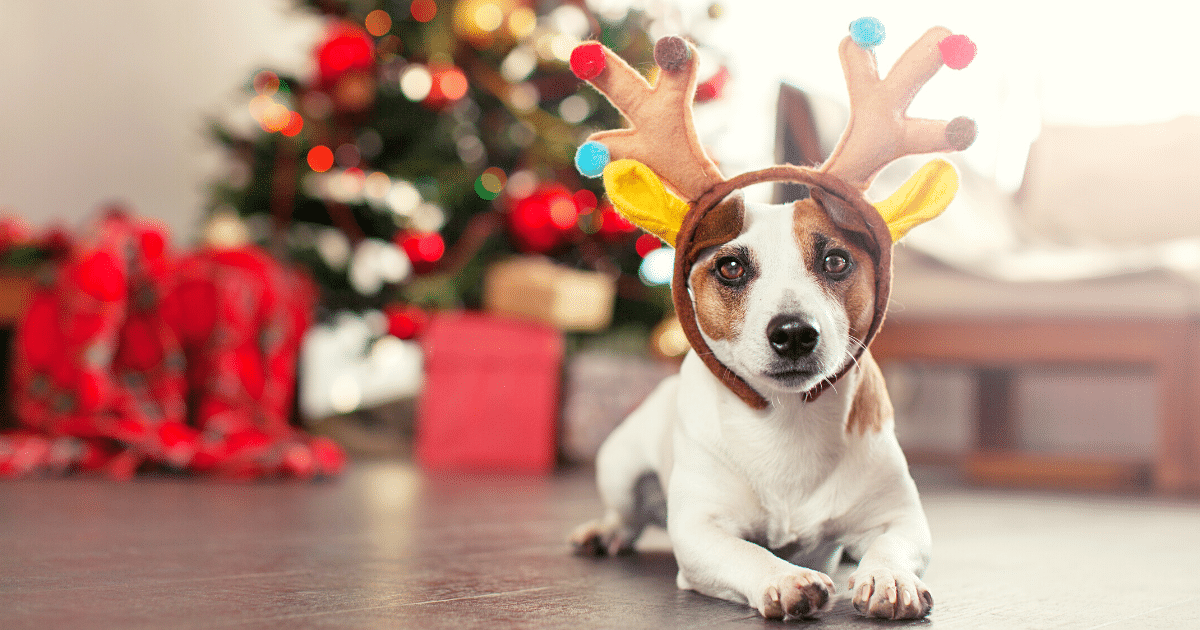
Tree Safety
Traditional Holiday trees and their trimmings can pose an array of safety and health threats to pets. Here are some common ones to be aware of.
-
- Tinsel is irresistible to many pets, and if ingested, can cause intestinal blockages. Ditch the traditional silver stuff and look for pet-friendly alternatives.
- Avoid glass and other ornaments that are sharp. Cats especially will be tempted to swat them off the tree, where they can break and cut paws.
- Flocking and artificial snow can be toxic if consumed in larger amounts, so it’s better to avoid them altogether.
- Keep ornaments on the upper parts of the tree, out of reach.
- Tree water often contains chemicals that extend the life of the tree. These chemicals, in addition to any fertilizers, insecticides, bacteria, and flame retardants, can make the tree water dish a toxic soup. Cover the stand with a tree skirt, aluminum foil, or other material to block off access from pets.
- If your pet is partial to chewing pine needles, which can cause intestinal upset, consider a faux tree.
- Anchor your tree with a sturdy base, and perhaps even fishing line attached to eye bolts in the ceiling or wall for added stability, to prevent a climbing-and-toppling hazard.
- Don’t put gifts under the tree that contain food, as these might be too tempting and sicken a curious (or food-driven) dog.
- Consider using a baby gate to keep pets away from the tree.
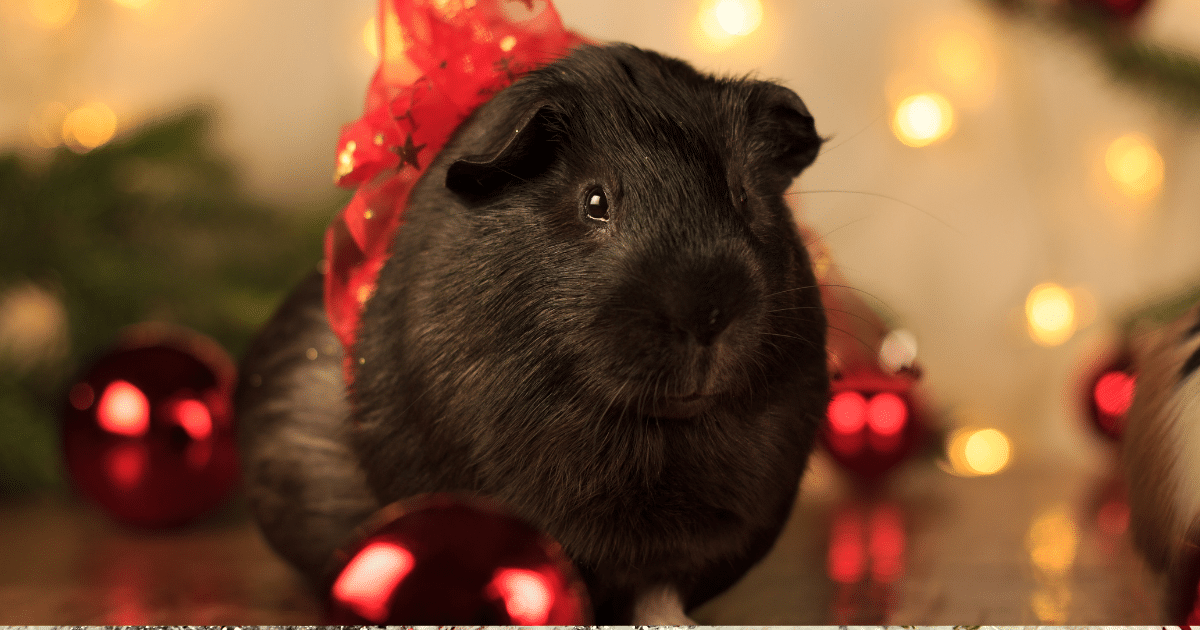
Decorations and Seasonal Plants
Take care in selecting decorations and plants around your home by keeping the following in mind.
-
- Poinsettias, pine needles, mistletoe, and holly can cause gastrointestinal upset and other problems, and lilies are toxic to cats and can cause kidney failure. Silk and other faux plants make great alternatives.
- Glues and adhesives can be toxic, so keep them out of reach.
- Watch out for yarn, string, and ribbons, which are often attractive to pets and can cause intestinal blockages.
- Switch out live candles/flames for LED lights, which add plenty of holiday warmth without the risk of fire or injury.
- Potpourri often contains oils that can be toxic to pets if eaten.
- Chewing on electrical cords can cause harm or even death. Unplug cords when not in use and spray them with anti-chew solutions such as Bitter Apple. Check out pet-proof extension cords as well.
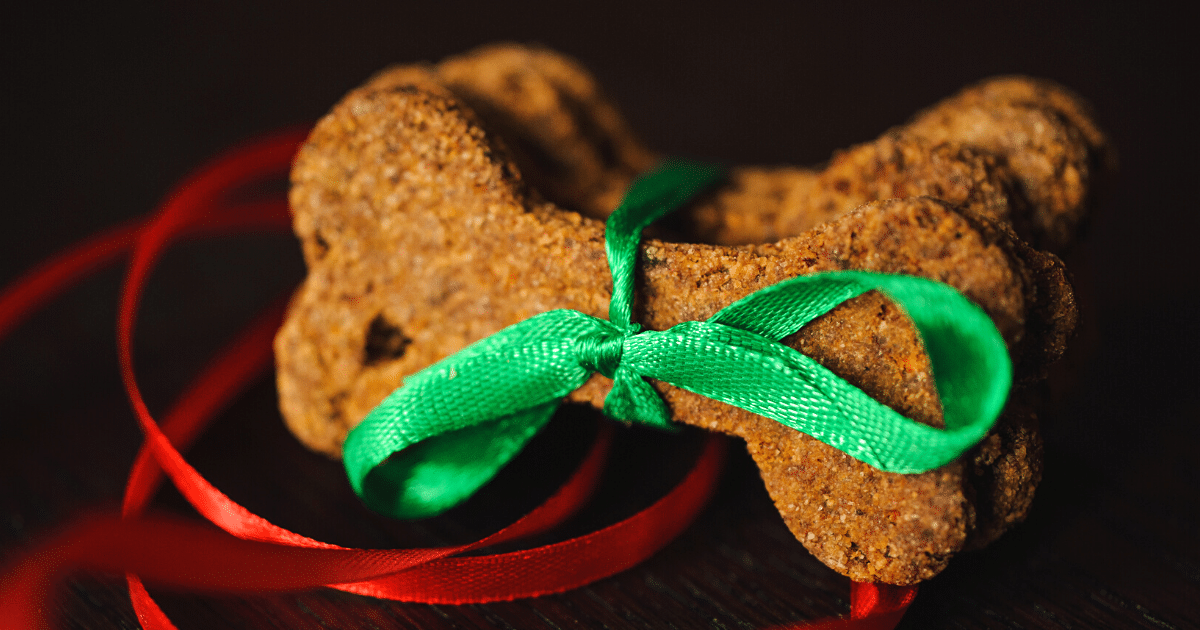
Food Dangers
Some pets will go to great lengths to sneak food. In the best cases, this means a holiday dish goes missing; in the worst cases, it can mean sickness or even death of a pet. Stay one step ahead of would-be food thieves with these precautions.
-
- Keep chocolate and other sweets well away from pets – preferably in a cupboard, the fridge, or somewhere else that’s secure.
- Do not leave food or alcohol unattended; stealthy pets can swipe them in no time and experience harmful effects.
- Avoid bringing home leftovers for pets. Human food – often containing fatty, spicy, or bones – can be hazardous to your pet. Some top offenders include chocolate, coffee, citrus, onions, grapes, nuts, coconut, dairy, and yeast dough.
- Being careful doesn’t mean you have to leave your pet out of the festivities – there’s plenty of store-bought or homemade options for special pet treats. Stock up on those for the holidays so they can join the fun.
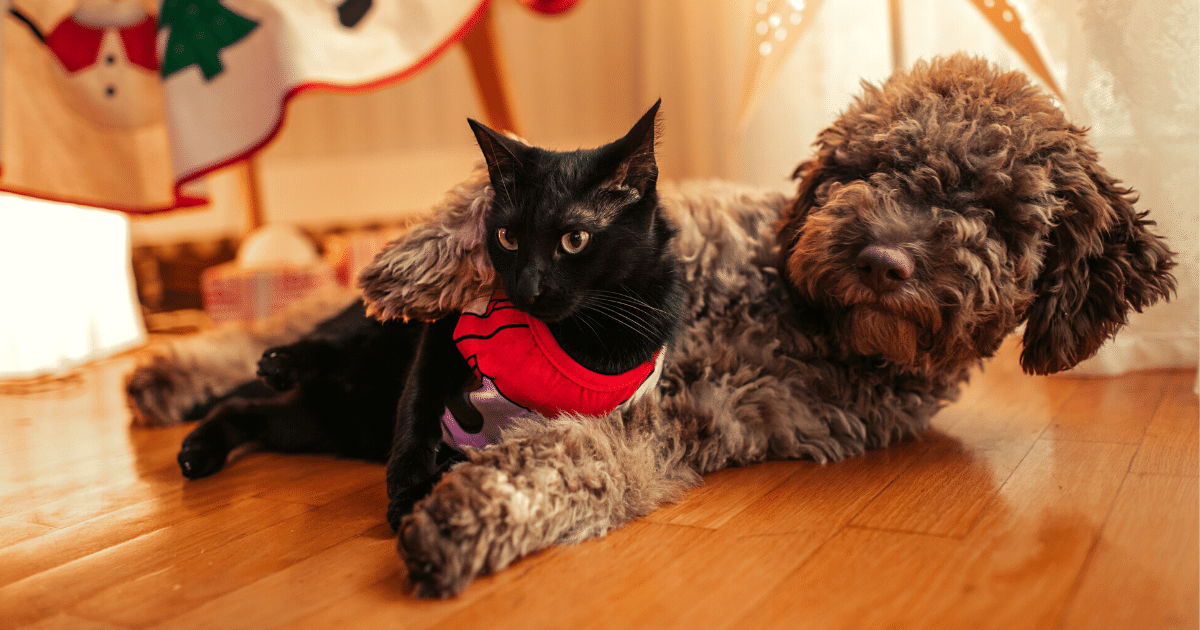
Entertaining
If you’re planning to host a few guests, remember that get-togethers can stress pets out or upset their routine. Here are some ways to keep them safe and calm.
-
- Give pets a room or space of their own, where they can retreat to if feeling stressed or overwhelmed. Stock it with fresh water, a bed, and their favorite toys.
- If celebrating at New Year’s, keep loud noises to a minimum.
- Animals sometimes will take advantage of the commotion or act out by getting into cabinets they don’t usually disturb, so be sure to hide away any medications, which can be extremely dangerous to animals.
Keeping your pets safe this season just takes a little creativity, forethought, and a new habit or two. And happily, the pet industry makes all kinds of pet-safe products and novelty items, so keeping the holidays safe for all family members should be easier than ever. Happy holidays!
This article is furnished by California Casualty. We specialize in providing auto and home insurance to educators, law enforcement officers, firefighters, and nurses. Get a quote at 1.866.704.8614 or www.calcas.com.

by California Casualty | News, Safety |
Although many of us won’t be able to visit friends, family, or loved ones this holiday season, that doesn’t mean we can’t still bring them joy or spread the Yuletide cheer!
Check out these 20 great holiday gift ideas for everyone in your life – no matter where they are.
1. Printable Coupons – Flex your creative muscles by making personalized coupons that can be printed out and redeemed later – for hugs, virtual family time, happy hour or anything, really! For a handmade touch, draw or paint them and send via snail mail or a digital photo.
2. Streaming Service Subscription – These days, there is no shortage of streaming service choices. Would anyone on your list like a subscription for movies, shows or music?
3. Gaming Subscription – Gamers can never get enough gaming time. Make sure you know which app or platform the gamer in your life uses before purchasing.
4. Audiobook Membership – Audiobooks are a great gift for book lovers for several reasons: they can “read” on the go, listen to master storytellers bring books to life, and have access to unlimited audiobooks (for most subscription platforms).
5. Donation – For those who have everything, donating to a cause you know they care about will give them some extra good feels for the holidays.
6. Museum Pass – Many people assume museums are closed, but in fact many have done a ton of work to go virtual. Get your favorite art lover a pass and help them get their art groove on.
7. Online Grocery Shopping Service – Help loved ones stay safe and give them some extra time in their day by gifting a subscription to their favorite grocer.
8. Food Delivery – Go one step beyond groceries and send a subscription for a food delivery service in their area. No dishes to clean, and a hot cooked meal delivered straight to their door? – yes, please!
9. Meal Delivery Kit – Halfway between groceries and food delivery, meal kits take the guesswork out of dinner prep, and will be much appreciated by any home chef.
10. Wine Subscription – Wine lovers on your list will look forward to new arrivals all year long. For those who aren’t partial to wine, check out subscriptions for beer, cheese, olive oil or other specialty foods.
11. Coffee or Tea Subscription – Broaden your favorite coffee or tea drinker’s horizon by getting them something new for their morning ritual.
12. Magazine or Publication Subscription – There’s a publication for everyone – all depending on their interests. Have a friend or family member who’s been wanting a digital newspaper subscription? How about a magazine all about one of their hobbies or interests? A google search for “online newsstand” should spark a ton of ideas.
13. Virtual Yoga or Gym Membership – Taking care of our own health is often last on the to-do list. Keep your loved ones healthy and help them lower their stress by getting them the gift of health.
14. Meditation App – Who couldn’t use a little calm and peace right now? Check out the many meditation apps available and find the perfect ones for your favorite people.
15. Online Learning Subscription – Have any curious, knowledge-thirsty folks in your circle? Send them a subscription for language courses, higher education classes or another online learning opportunity.
16. Subscription For Creative Arts – Creative projects can help keep us inspired and motivated during the long winter months. For the creatives in your life, look into crafting subscriptions, online painting classes, virtual music lessons, and other right-brain endeavors.
17. Virtual Scrapbook – Send friends or family a reminder of great times together (pre-Covid!) by assembling a virtual scrapbook of favorite memories. The great thing about an online versus paper version is that you can include videos in the mix of photos.
18. Makeup or Beauty Subscription – Someday we’ll have a reason to go out again, but in the meantime, receiving a regular beauty box can give a boost to those on your holiday list.
19. Membership – There’s an association or club for just about every passion, hobby or interest. Birding? Definitely. Fishing? Yep. Quilting, classic cars, sculpture? – there’s a club for that!
20. Professional Membership – Give a loved one a career boost by getting them a membership to a professional association in their field.
No doubt – this holiday season looks different than all the years past. But with some flexibility and creativity, we can still connect and celebrate with our loved ones. And surprise them with the perfect gifts! Happy holidays to all!
This article is furnished by California Casualty. We specialize in providing auto and home insurance to educators, law enforcement officers, firefighters, and nurses. Get a quote at 1.866.704.8614 or www.calcas.com.
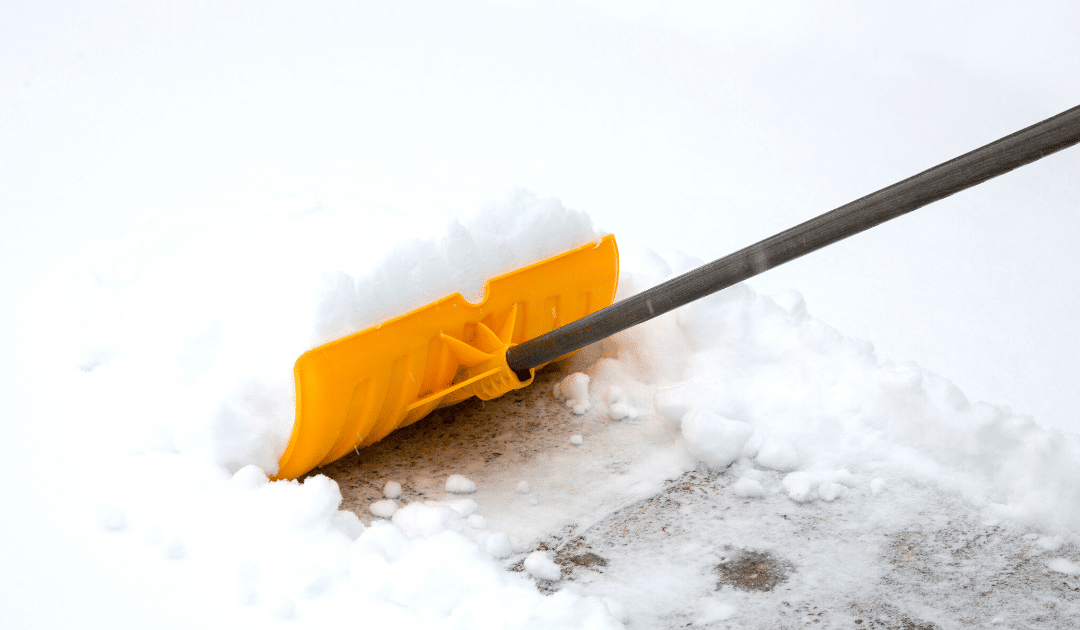
by California Casualty | Homeowners Insurance Info, Safety |
When temperatures start to dip and the days get shorter, snow and ice are soon to follow. If you live in a snow-prone area, it’ll soon be time to pull out the shovel, gloves, and boots and prep yourself for the snow shoveling season.
Here are some tips to stay ahead of the snow, protect yourself from injury, and make this necessary chore a little less taxing.
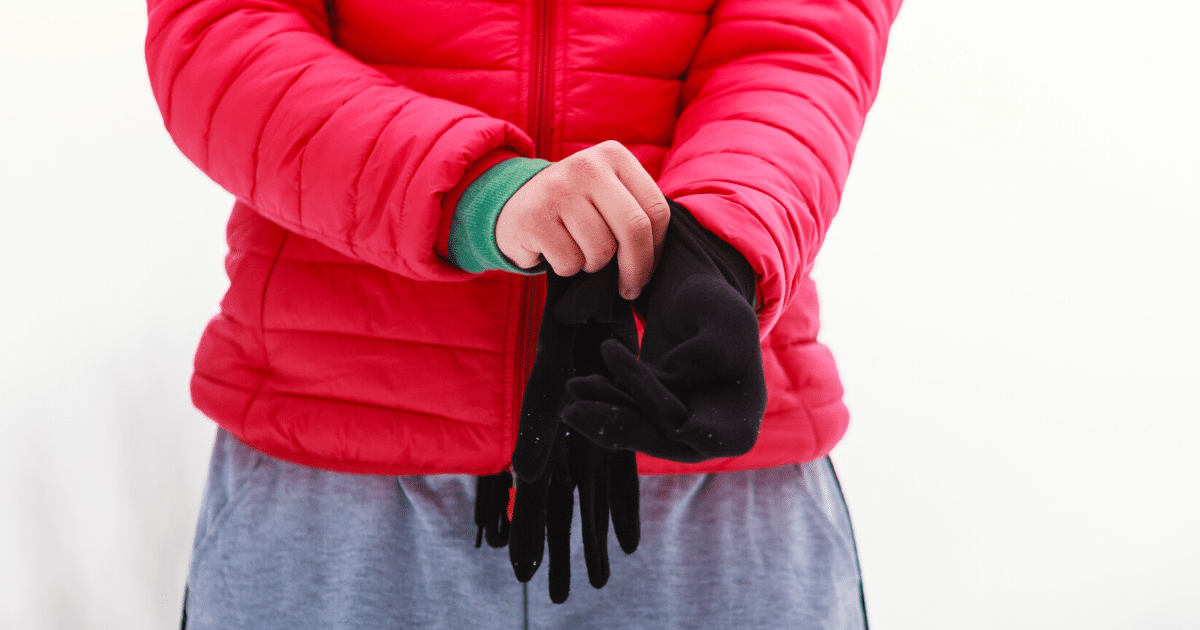
Before Shoveling: Prepare & Plan
- Warm-up – Do some basic stretches to limber up and prevent injury.
- Wear layers – Layers will keep you warm while allowing for full movement.
- Start early – Shovel new snowfall before it melts and refreezes into a slipping hazard.
- Make a plan – Before removing the snow, figure out where you’re going to move it to.
- Choose the right shovel – Make sure your shovel fits your hands and frame. Choose from ergonomically-designed models that can reduce bending and strain.
- Consider wax – Coating your shovel blade with wax (car wax is fine) will prevent heavy snow from sticking and freezing to the blade. This works best on metal shovels.
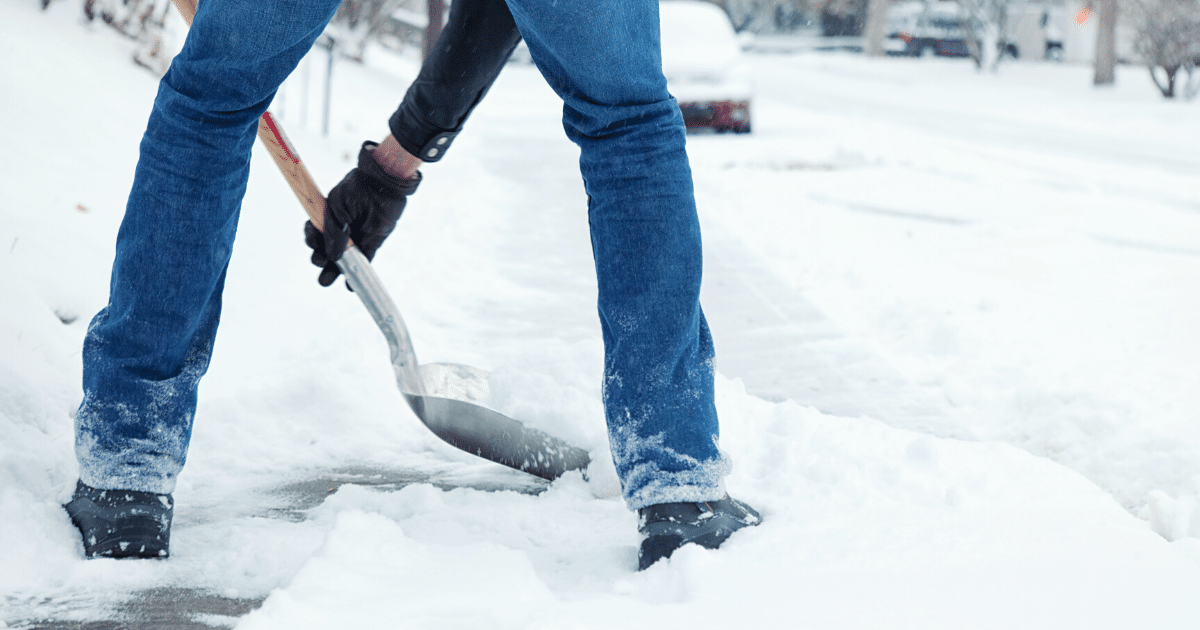
While Shoveling: Technique & Habits
-
- Push, don’t lift – Pushing snow is easier on your body than lifting it. In times where lifting is unavoidable, be sure to:
- Bend your knees and keep your back straight.
- Position your feet hip-width apart and use your legs for leverage.
- Avoid twisting with a loaded shovel.
- Keep your shovel close to your body — This will help prevent injuries.
- Keep it bite-sized – Shovel smaller loads rather than large ones. Also, focus on the powder rather than heavy ice.
- Change up your grip – To prevent blisters and strain, switch up left- to right-handed shoveling. Also change it up with palm under/ palm over.
- Take breaks – Especially if the snow is wet, be sure to hit pause every 20 or 30 minutes.
- Stay hydrated – In cold weather, it’s easy to forget to hydrate, so be sure you have water available and remember to drink it.
- Shovel snow while it’s falling – You’ll lighten your workload if you periodically remove snow while it’s falling.

Managing the Yard
While shoveling, keep your yard and home exterior happy by keeping these tips in mind.
-
- Don’t let snow pile up – If branches are weighed down with snowdrifts, gently brush the snow off to prevent branches from bending under the weight and snapping. And when you’re shoveling near them, remember to not dump the snow on plants.
- Make a windbreak – If it works for your yard, you can deposit each shovelful of snow to form a barrier that shields shrubs and plants from wind damage.
- Clear snow from the dryer vent – A blocked dryer vent is a fire hazard and can put your family at risk of carbon monoxide poisoning. Make sure your vents are clear of snow build-up.
- Keep the fire hydrant clear of snow – If you have a fire hydrant at the front of your yard, make sure part of your maintenance is to keep it clear in case fire crews need to locate and use it.
- If you park in the driveway – Clear a path to the driver door first, so that you don’t have to trudge through the snow to get to it.
As long as there’s snow, there will be snow shoveling. By using the tips above, you can make this task a bit easier and prevent injuries in the process.
This article is furnished by California Casualty. We specialize in providing auto and home insurance to educators, law enforcement officers, firefighters, and nurses. Get a quote at 1.866.704.8614 or www.calcas.com.

by California Casualty | Homeowners Insurance Info, Safety |
Did you know that cooking fires in residential buildings happen more often on Thanksgiving Day than any other day of the year? Or that peak timing for fires is from 10am – 4pm — right when everyone’s preparing their turkey day feasts?
According to the National Fire Protection Association, unattended cooking is by far the number one contributing factor of cooking fires and fire deaths.
The following tips from NFPA will help you avoid the common pitfalls and serve up a holiday full of delicious dishes, happy memories, and a safe celebration.
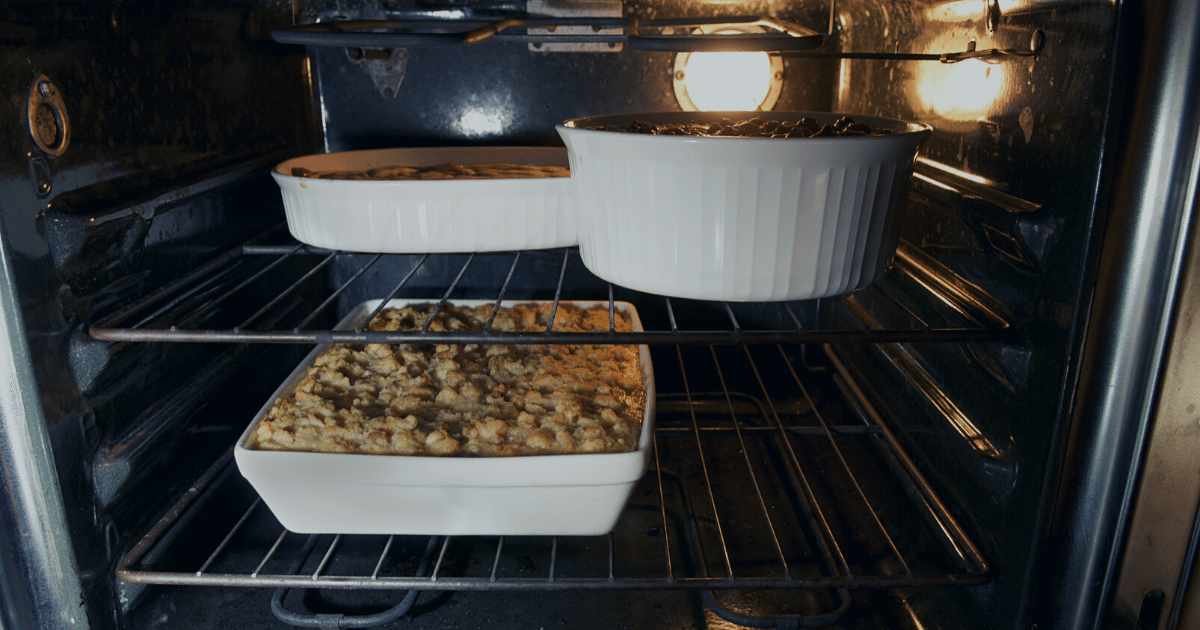
Remember to:
-
- Stay in the kitchen when cooking as much as possible:
-
- If you’re frying, boiling, grilling, or broiling food and need to leave the kitchen for even a short time, turn the stove off until you return.
- If baking, simmering, or roasting, check it regularly, stay in your home, and use a timer to remind you when it’s close to done.
- While cooking turkey, check on it frequently, and do not leave your home.
- Test your smoke alarms a few days before the holiday to make sure they’re working.
- Keep oven mitts, food packaging, towels, and any other flammable materials away from your stovetop.
- Keep the kitchen floor free of tripping hazards.
- Don’t use the stove or stovetop if you’re sleepy or have consumed alcohol.
- Be mindful of children:
- Keep them at least 3 feet away from the stove.
- Make sure knives, electric cords, and matches/lighters are out of reach.
- Ensure they stay away from hot food and liquids.
- Never leave them alone in a room with a lit candle.

Prevent a Fryer Fire
Deep frying turkeys is all the rage — and unfortunately causes plenty of fires and injuries every year. If you plan to fry this year, follow these safety tips from the U.S. Fire Administration:
-
-
- Only use a unit specifically made for frying turkeys — don’t try to adapt cookware you already have.
- Only use the fryer outdoors on a sturdy, level surface that is a safe distance from anything flammable. Remember that fryers can easily tip over, spilling hot oil. Maintain a 3-foot zone free of kids and pets to protect against injuries.
- Make sure your turkey is fully thawed before frying it — a partially frozen bird will cause hot oil to splatter.
- Ensure that you use the correct amount of oil. An overfilled fryer will spill over when the turkey is placed inside.
- Do not leave the fryer unattended. A 15-pound turkey will take about 45 minutes to cook, so prep in advance so that you can stay outside the whole time.
- Use gloves and have extra potholders and supplies nearby. The pot, lid, and handles of the fryer can get very hot.
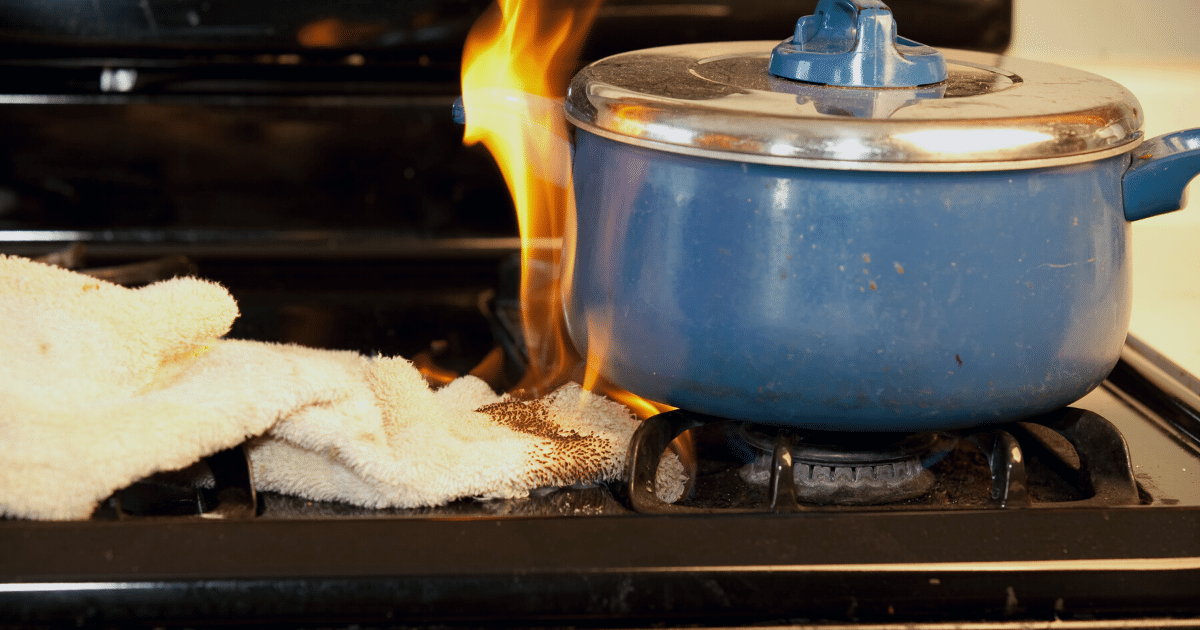
In Case of Emergency
A small grease fire can erupt suddenly — even despite best efforts at prevention. Here are some basic steps from the NFPA if one erupts on your watch.
-
-
- For an oven fire, turn off the heat and keep the door closed.
- If on the stovetop, smother flames by putting a lid or baking sheet over the pan, taking it off the heat, and turning the burner off. Leave the pan covered until completely cooled.
- Do NOT pour water on a grease fire — it will make it worse or even spread the fire. A lid or cooking sheet is best; pouring baking soda or salt on small flames can also help extinguish them.
- When in doubt, get out of the house. Close the door behind you and call 911.
The holidays are busy. Between cooking and hosting time and focus can feel scant. To let you focus on cooking — safe cooking, that is — enlist the whole family to help. Tasks such as shopping, decorating, and cleaning can be delegated. While in the kitchen, make sure someone else is on point for entertaining and taking care of things in the rest of the house. Finally, prepare activities (games, puzzles, books, etc.) ahead of time for children so that they’re occupied and out of the kitchen.
And most important: enjoy that precious time with your family — over a delicious, beautiful meal!
This article is furnished by California Casualty. We specialize in providing auto and home insurance to educators, law enforcement officers, firefighters, and nurses. Get a quote at 1.866.704.8614 or www.calcas.com.





























